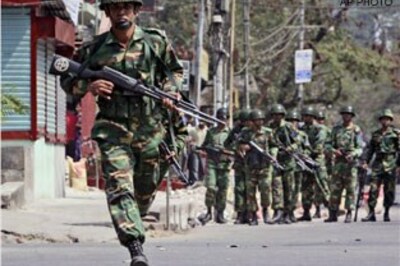
views
As flood waters suddenly gushed down the hill near the Amarnath shrine last Friday, it brought back horrid memories of the flash floods in Kedarnath – one of the country’s worst natural disasters. Carrying huge amount of silt and debris, the water created a sheer force that swept away everything that came in its way.
“The weather was fine all day, except between 4:30 to 6:30 pm when our automatic weather station at the holy cave recorded 28mm rain. But it wasn’t this rain that triggered the flash flood, but the heavy rain in the upper catchment areas that was perhaps much more than what our stations recorded,” Sonam Lotus, director of the meteorological department at Jammu & Kashmir, tells News18. “Sometimes, despite monitoring weather 24×7, it is not in our hands…”
So far, 16 people are confirmed to have lost their lives in the tragedy, while the search operation is still on for 40 others who remain missing, even as the Yatra resumes via an alternate route.
The India Meteorological Department (IMD) continues to assert that it was not a “cloudburst” but a “highly localised, heavy rainfall event,” that was difficult to predict. A ‘cloudburst’ is recorded when the clouds dump 100mm rain within just an hour. But of all the automatic weather stations installed at Amarnath, Baltal, Panchtarni, only the one at Amarnath recorded rain that day – 28mm.
Either way, the unpredictability of the weather and the subsequent loss of lives is a grim reminder of how fragile the landscape of the western Himalayan region is and its extreme susceptibility to natural hazards. Such is the orography of the region that even 60mm rain is enough to trigger flash floods that could wreak havoc, say scientists.
Senior meteorologist Anand Sharma, who led forecasting of Kedarnath floods in 2013 during his term at IMD, says no weather forecast can be 100 per cent accurate. “The orography of this region is so diverse. There are so many hills, and each hill has its variations, the weather stations will never be enough. There is definitely a need for improvement of our radar network in the region, but even then, we must understand that it’s weather and its forecasting cannot be 100 per cent accurate.”
It may be too early to say if any weather event carries an imprint of climate change, but it definitely warrants the need to scale up our vulnerability assessment. Scientific evidence shows how climate change is causing a change in rainfall patters over the Indian sub-continent, especially during the four-month monsoon season – which also coincides with the commencement of the pilgrimage to the north. The loss of lives in such disasters signals a failure of our early warning weather systems, which are riddled with executional challenges on the ground and are extremely critical.
But each time we falter, the human cost of a disaster only rises. Himalayas are a high-risk environment and the people living in the vulnerable region are not only bearing the brunt of weather extremes, but also the lack of adequate early warning system and disaster preparedness. The judicious use of Himalayan resources is critical, and so is the need to prevent the region from getting overwhelmed.
Scientists have time and again warned that the atmosphere is indeed becoming more unstable because of global warming. Long-term studies show how the frequency and intensity of weather extremes have increased over the country. There are now more number of days with heavy rainfall (>150 mm in 24 hours).
A study by Indian Institute of Technology (IIT) Bhubaneswar, Odisha, showed how there was an increase in the moisture content of atmosphere over India due to consistent increase in surface warming induced by climate change, leading to rainfall extremes. Another study published in PNAS points at increase in frequency of snow avalanches in the western Himalayan region due to warmer winters and early spring in recent decades.
The effects are definitely more pronounced in the Himalayan region, which has been exposed due to increasing habitation, construction activities and the steadily expanding traffic and road network. Not just cloudburst, but any kind of heavy rainfall could potentially trigger disastrous flash flood in this fragile ecosystem with undulating slopes. The probability of such events is even higher in the monsoon season.
We may have come a long in our weather forecasting, but the loss of lives during each extreme weather event shows that it is still far from enough. Be it cloudburst or flash floods, we cannot prevent such events from happening, but we can certainly brace ourselves and amp up our capabilities to mitigate it.
Read all the Latest News and Breaking News here




















Comments
0 comment